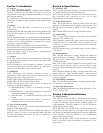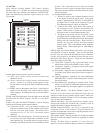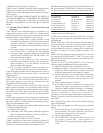
7
across the coil to suppress reverse voltage that is generated
whenever the inductive load is de-energized. This will protect
the electronic components in the MC-900 and should prevent
operating malfunction due to noise. The “rule of thumb” for
sizing the reverse diode is to use one with a PIV (Peak Inverse
Voltage) rating equal to the operating voltage or at least 100
volts and a current rating that is equal to or greater than the
forward current that the coil draws to operate. For example, a
relay less than 1 A, use a 1 A diode since they are readily
available. The wiring shown in figures 4-2.3.1 and 4-2.3.2 have
examples of the places that a reverse diode is required.
4-3 Overspeed Switch.
4-3.1 A magnetic pickup is recommended to supply the speed
signal for the MC-900 series overspeed switch. This pickup
will be mounted in the flywheel housing in line with the ring
gear on the flywheel and wired to the MC-900 using either a
twisted pair or a shielded cable to reduce the possibility of
electrical noise pickup in the wiring.
4-3.2 The tachometer terminal, of the battery charging
alternator, may be used for the speed signal but a broken drive
belt will disable this source and some alternators have
electrical noise which will cause the speed switches to operate
at speeds well below the desired RPM.
4-4 Pre-operational Check-out.
4-4.1 After installation is complete, it is necessary to make
some adjustments to the MC-900 SELECTRONIC
®
Control
before the system is operational. All shutdown circuits also
should be tested. Table 4-4.1 lists the standard factory setting
of the adjustable functions on the MC-900 series control. To
determine if the frequency of the speed switch must be
changed, calculate the required setting using the following
formulas:
Refer to Table 4-4.1 to determine if the speed switch setting is
below the factory setting listed. If required frequency will be
higher than the standard, increase the setting before
proceeding. Turn the Overspeed Set pot clockwise to increase
setting. The adjustment is a 20 turn control without stops at
either end.
4-4.1.1 Be sure to have a fully charged battery to do these
tests. Low battery voltage can cause improper results during
the tests.
4-4.1.2 All of the adjustments and controls shown in Table 4-
4.1 are located on the rear of the control/display module. See
Figure 4-4.1.2. Each light and switch is labeled for ease of
identification. The LED’s are supplied as an aid in installation
and troubleshooting of the MC-900.
4-4.2 Start and Stop Engine; to test the start and stop function,
proceed as follows:
(a) Double check all wiring to be sure it is connected.
(b) Turn Mode Selector switch to the START position.
(c) Engine should crank and start. Return switch to RUN
position.
(d) When engine has come up to speed and governor has
Fuel Relay
Crank Relay
Crank
Time
Lockout
for start T.D.
Close Only One
Pickup
Present
SW1 = 10 s.
SW2 = 15 s.
SW3 = 20 s.
SW4 = 25 s.
SW5 = 30 s.
Torque
Scews to
12 In./lb.
15
26
04
27
28
04
29
30
31
32
33
34
35
36
37
38
39
40
41
42
43
44
45
46
Overspeed Overspeed
Test
Overspeed
Set
Overspeed
Relay
Shutdown
Relay
Torque
Scews to
12 In./lb.
40-05-0416
SW1 = Oil Pr
SW2 = Wt Tem
SW3 = Spare #1
SW4 = Spare #2
SW5 = Spare #3
SW6 = Spare #4
1
0
2
N
345671
0
2
N
345
CLOSE
PUSH
OPEN
Figure 4-4.1.2
No. of Gear Teeth x RPM set points
60
Set point
frequency in HZ
Pulley ratio x No. of Alternator Poles x RPM set points
60
Set point
frequency in HZ
=
=
OR
Function
Standard
Setting
Adjustment
Range
Adjustment
Type
Crank Time
15
seconds
10, 15, 20, 25
and 30 Seconds
Switch
Overspeed
3894 Hz
300 to 10 KHz
Pot. 500 Hz per
turn CW to increase
Lockout
for Start
SW1, SW2
Closed
SW3, 4, 5, 6
Open
Switch–
Table 4-4.1















